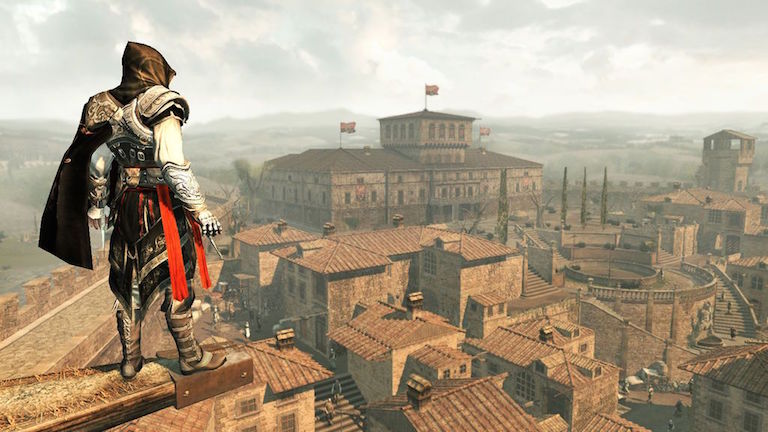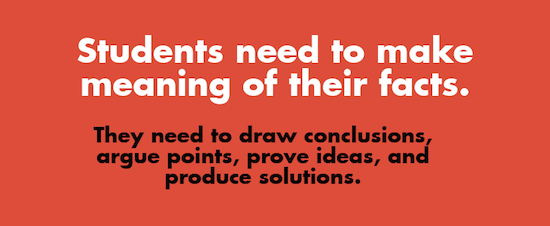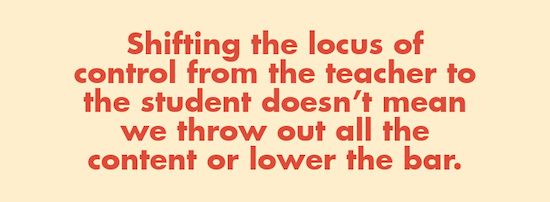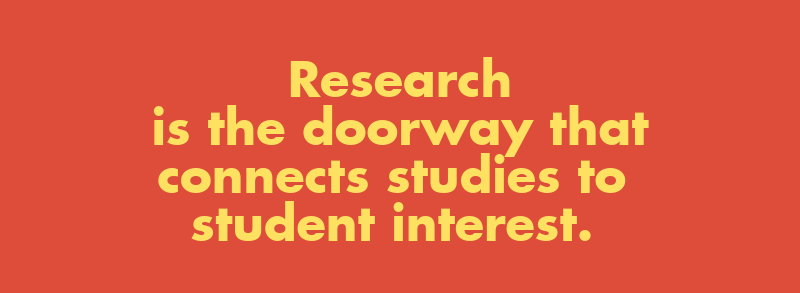How We Can Make Research Matter to Kids
I was sitting in a circle with a group of 25 ninth graders, ready to assist them with the annual freshman research project where each student is assigned an important figure from the Renaissance to research.
“So, your teachers have given you this huge research project,” I said. “Tell me. When you get an assignment like this, what is the hardest part for you?”
One notably quick-witted boy, Drew, looked at me with a sarcastic, raised eyebrow, and said out of the side of his mouth, “Caring.” The other kids snickered. I refocused them, talking about finding sources and note-taking, but Drew’s answer sat stubbornly in the back of my mind.
When I had a moment to sit privately with Drew, I asked him to explain his answer. “What would make you care?” I inquired. He looked at me, that one eyebrow still arched, a tuft of hair over the other eye, and told me that he didn’t need my assistance. He would do whatever minimal work he needed to do to get a B and just go on not caring. “But,” I interrupted. “What would make you care? What could get you hypothetically excited about this assignment?”
“I would care about this project if it actually had something to do with me,” he told me. “I mean, here I am, researching and spitting out facts about Donatello—and guess what? I don’t care about Donatello. He has nothing to do with me or anything I’m interested in.”
“Is there anybody you would care about?” I asked him.
“Yeah,” he said. And that’s when I first got a glimpse into Drew’s world. “There’s this dude in Assassin’s Creed Renaissance—his name is Ezio Auditore da Firenze—and he’s kind of cool. I want to know if he was real or not.”
I encouraged Drew to do a little bit of reading on Ezio, and he discovered that while the character is loosely based on a real historical figure, there is very little documentation to support this, so Ezio’s main characteristics are pulled from several historical figures. There was not enough available information. Drew looked at me. “Well, I guess I’ll just go back to researching Donatello then,” he said, shoulders slumping, resigned.
“Hold on,” I stopped him. “What else interests you about this?” He looked at me hesitantly. “Really?” he asked. I nodded. “I want to know what kind of research the people who created Assassin’s Creed had to do in order to develop this game. I mean, did they actually go to these places? Are the streets the same? Those clothes they wear—is that what people wore? Do they hire historians and stuff?”
This conversation launched a deeper discussion between Drew, the English teacher, and me, and instead of doing a biographical project, Drew worked with us to re-create his assignment, which now was:
How would the video game Assassin’s Creed Renaissance be different if it had actually taken place during the Renaissance?
As Drew jumped into his research over the next few weeks, his arched eyebrow began to relax into the furrows of invested study. He began to tell me how the developers of Assassin’s Creed form internationally and ethnically diverse groups so as not to have any unintended bias. They visit the cities they create in their video games. They research the history of the time period thoroughly, using primary documents.
We watched Drew become more engaged as he learned more about the Renaissance than almost any other kid in the class. Ultimately, he concluded: No, Assassin’s Creed Renaissance would not be any different—the creators of the game had done such thorough research themselves they were able to stay true to the historical context of the time period, and then he was able to support those findings with specific examples.
Drew’s original disconnect is not an anomaly—it is the story of many of our students—and he left me asking myself What are we asking our students to do?
What Are We Asking Kids to Do? Making the Shift
We’ve all collected research projects that have been less than inspiring. A list of facts glued onto a poster board. PowerPoint presentations with ten bullets on a page that are all but plagiarized. Essays that are five paragraphs of formulaic writing that, at their best, are boring and, at their worst, chaotic and disorganized. Let’s agree that this is not the kind of research that encourages critical thinking or creativity.
Too often, when students (and let’s be honest, teachers) hear the word “research,” they associate it with the tedious, boring process of gathering and reporting on collected facts. And, indeed, the base of all research is fact-finding. But fact-finding is no longer enough in the data-rich society we live in.
Instead, we want assignments where students do something with their facts. I don’t mean put them in a brochure or on a website—no matter how beautiful you make it, regurgitating information is still regurgitating information. What I mean is research should always build to something greater in either an organized classroom conversation, writing, or presenting.
Students need to make meaning of their facts—they need to draw conclusions, argue points, prove ideas, and produce solutions. They don’t need to know a list of facts they can look up anytime; they need to understand how their facts work together. And this should be challenging and fun! It should be the inroad to our curriculum where students can freely explore.
If we want research to engage our students and jumpstart creative and critical thinking, we have to intentionally shift our assignments. So how do we make this shift? First, let’s ask some questions while we unpack Drew’s case for clues as to why he moved from being a ininterested learner to an enthusiastic one.
Do our Assignments Offer Choice and Autonomy?
Drew had choice in his final topic, and this gave him autonomy over his work. When students have a voice in which direction they will explore, they will pick subjects that interest them, which will encourage them to work through the harder parts of research.
Research is a naturally recursive and sometimes frustrating process, meaning it’s normal to have to backtrack and change gears. When students feel ownership of their course, these changes in direction feel more natural to the process and less like they aren’t “doing it right.” It also makes research something they do rather than something that is being done to them.
Choice doesn’t mean providing students with a list of topics to draw from though. While technically, yes, this is still a “choice,” this strategy just gives students teacher-directed topics to choose from, not student-driven avenues of learning.
Shifting the locus of control from the teacher to the student doesn’t mean we throw out all the content or lower the bar; we just change the course so that we guide students through a space that grants them room to investigate larger themes.
Remaking Our Research Assignment
Taking the lessons we learned from Drew, the teacher and I (in my librarian role) readjusted the assignment the following year.
Instead of providing a list of famous people from the era, we provided stacks of books, a resource guide of online sources, and our databases, and then asked students to spend a day in the library reading everything they could and choosing something about the Renaissance that they wanted to dig into.
From there, they began to develop a focus and eventually their own essential question. Students developed projects like, “What would air travel look like today if da Vinci’s airplane model was built during the Renaissance?” and “How did Renaissance fashion influence later fashion movements?” and “How has modern medicine evolved from Renaissance practices?”
In all of these studies, students had to look up facts, most certainly, but their ultimate conclusions were drawn by them. They created meaning through their discovery. Providing choice does not mean asking students to lone-wolf it through curriculum. It is just shifting the locus of control, making the teacher a guide and a resource through the process.
Every day that students were in the library working, I checked in on Drew. He always sat away from his friends with his laptop open and notes strewn around him on the table, working independently. He always had something new to talk about with me. Drew had autonomy over his research project and from where I stood, that looked good.
Is There Greater Purpose and Relevancy to Our Assignments?
Stop and think about yourself as a learner for a moment. I’m certain I am not the only teacher who has sat in a stuffy gym for district-provided PD listening to somebody talk about a topic that doesn’t feel applicable to me, wanting to get back into my classroom to dig into the work I know is important, wondering what is the purpose? How is this relevant to my practice?
The documentation I’ve produced after such sessions has been forgettable, dryly written work that I stuck somewhere in a folder. In contrast, I have spent countless hours researching for my book, building websites for initiatives, and reading and writing about educational issues that matter to me. I have produced work that I am proud of and that I continue to reflect upon.
Purpose drives the paths we take.
And purpose looks different for every person. Sometimes it is about making ourselves a better person. Sometimes it’s about sating curiosity. Sometimes it’s to serve others. Often it is about proving a point. It always results in intentional learning.
When Drew undertook his new Renaissance project, he had two purposes:
- He was genuinely curious about the construction of the video game he plays, and he is considering going into the video game business as a career. He wanted to know what that career path might entail.
- He belongs to a group of friends and a virtual community who all play Assassin’s Creed, and he was excited to share this information with them and appreciate the game at a whole new level.
We learned from Drew that purpose is important, and so we started asking students why they were delving into this study and who would be reading it. The following year, a community production of Romeo and Juliet was coming to our school, and the students produced an entryway research display that provided context for the play. When learners know that there is a purpose for their work, they connect their learning to their world in relevant ways, and produce higher quality work.
Relevancy in learning is the magical congruence of what a student wants to know and what a student needs to know, and that can be a challenging, formidable balance for us to juggle.
This is where research steps in. It is the doorway that connects studies to student interest. Relevancy is intimate and personal. We are passionate about different topics because our collective experiences differ from one another’s.
Assassin’s Creed was relevant to Drew’s life. If a teacher assigned me an Assassin’s Creed research project, I would become your worst student: I’d be passive aggressive, roll my eyes, wait until the last minute, and then turn in lukewarm work that bored you. It would not interest me.
We discovered from Drew that it was important to learn about our students as they learned about their topics in order to guide them through the making sense of it. In the Renaissance project, a student who struggled with drug abuse was interested in the role apothecaries played in addiction. Another who had lost her mother to cancer wanted to investigate how illness was treated during the time period.
This is how we power up research. When students are given the skills to connect our content to their worlds, their work will become important to them.
________________
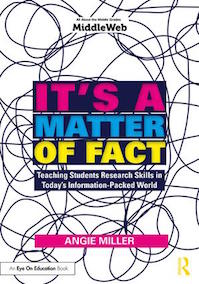
She is also the recipient of the 2017 New Hampshire Library Program of the Year award and has been a TED speaker and a National Geographic Teacher Fellow. Follow her on Twitter @angieinlibrary.
It’s a Matter of Fact is co-published by MiddleWeb.


